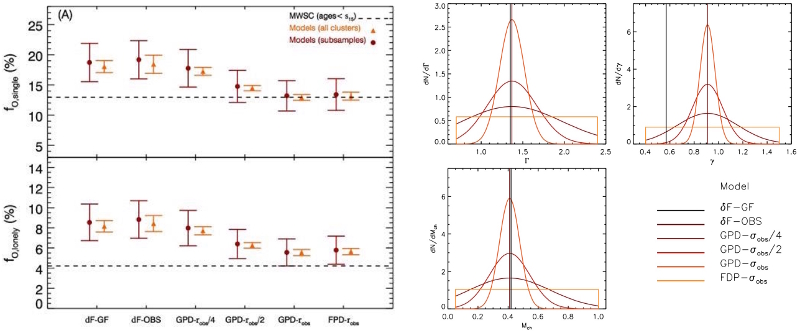| EPoS Contribution |
|
A non-universal IMF in the Milky Stellar Clusters
Sami Dib Niels Bohr International Academy, DK | |
| I will present a novel method to infer the distributions of the parameters that describe the IMF (slopes at the low and high mass ends, and characteristic mass) for the population of young clusters in the Milky Way. The novelty and power of the method is based on the fact that it relies only on the statistics of the high mass content of the Milky Way clusters, but is able to yield information on the parameters distributions of the IMF over the entire mass range. This is achieved by appropriately comparing the statistics of massive stars in a recent catalog of Milky Way clusters (the MWSC catalog) with a very large library of synthetic clusters built with various initial cluster mass functions, and including corrections for the binary population, stellar evolution, completeness, and estimates for the effects of dynamical evolution. We find that the distributions of the IMF parameters required to fit the observed fractions of single O stars in clusters are sufficiently broad such as to invalidate the concept of a universal IMF. Furthermore, our results seem to rule out the existence of a cluster mass-maximum stellar mass relation. These broad distributions of the IMF parameters very likely reflect the existence of equally broad distributions for the initial conditions under which these clusters have formed in porto-cluster clumps. | |
 | |
| Caption: The dashed lines in the left panel show the fraction of isolated O stars (single O stars in the cluster), and lonely O stars (single+absence of B stars) in the young (< 12.5 Myrs) population of the Milky Way stellar cluster catalogue. The orange triangles and red circles show two different ways of measuring the same quantities in synthetic clusters. The synthetic clusters are constructed with parents distributions of their IMF parameters that go from δ functions which means all clusters have a universal IMF (δF-GF, and δF-obs) to having their parameters drawn from broad distributions (GPD-σobs, and FPD-σobs) (right panel). | |
| Collaborators: S. Schmeja, ARI, Heidelberg & U. Hannover, DE S. Hony, ITA, Heidelberg, DE S. Basu, UWO, London, CA |
Key publication
Suggested Session: Star formation "laws" and IMF |

